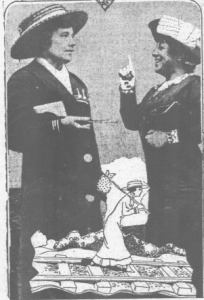
In the 1910’s one woman made it her personal mission to bring attention to the plight of homeless people, especially homeless women. Her life story is not immediately clear and she does not seem to have any biographies written on her. Instead, her memory lives in the pages of newspapers. This is what we currently know about her.
Cora Harvey’s activism on behalf of homeless people first began when she was working as a recorder in Oklahoma. (Notably, she was reportedly counted among the first women to hold public office in the country.) There she saw men and women struggling under extensive economic pressures, often out of their control. Her reserve was further strengthened when she spent some time as a hobo. She gradually began to see a sharp divide in how men and women were treated when faced with these situations. While it was acceptable, and to a degree expected, for men to travel in search of jobs, increased social stigma prevented women from doing so. Additionally, much of the charity work directed at homeless/jobless people was directed for men, leaving women with nowhere to turn.[1]
She soon joined up with people that shared her convictions. By 1909 she would join the Brotherhood Welfare Association, a socialist group comprised of “hobos” which attempted to advocate for improved economic conditions. She was named secretary of the organization and could travel around the country giving speeches.[2] She would also serve as the only female representative at the organization’s national meeting in 1912. While there she railed against capitalism, believing that those in the lower socioeconomic classes would never be able to thrive under the system.[3] It isn’t clear how long she held onto the role of secretary though it is apparent that she maintained her position until at least 1914.[4]
Activism on behalf of homeless people did reach some success in this period. In 1913 the International Itinerant Workers’ Union, also known as the Hoboes of America, were officially endorsed by the American Federation of Labor. This agreement had at least three major effects. Hoboes would refuse to serve as strike breakers when their fellow union members went on strike. In addition, each group would in essence back each other up in times of crisis Furthermore, a more social consequence meant that hoboes were shown to be skilled competent people, removing some of the stigma from the term.[5]
That is, unfortunately, where the newspaper trail of her seems to end. She is mentioned as speaking at a number of gatherings and conventions though noting was found on her personal life. If you are interested in writing a paper on an obscure person then she would be an interesting subject. As always, please feel free to contact the History, Philosophy, and Newspaper Library with any questions or new findings.
[1] Idah McClone Gibson, “Do You Know There Are Girl Hoboes And Women Hoboes In This City?,” Daily Book (Chicago, IL), May 24, 1913.
[2] “Hoboes Want a Newspaper,” Rock Island Argus (Rock Island, IL) Apr. 13, 1909; “Lead New York’s Unemployed Army,” Spokane Press (Spokane, WA), Jun. 19, 1909..
[3] “’Bos Convene Despite Protests – Talk Money,” Day Book (Chicago, IL) Feb. 2, 1912.
[4] “Woman Will Lead Workless Parade,” South Bend News-Times (South Bend, IN) Jan. 23, 1914.
[5] “American Federation of Labor Recognizes Hoboes,” Daily Book (Chicago, IL), May 17, 1913.